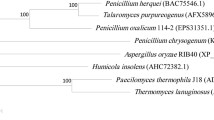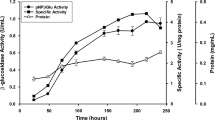Abstract
β-Glucosidase (BGL) is a rate-limiting enzyme of lignocellulose hydrolysis for second-generation bioethanol production, but its inhibition by lignocellulose pretreatment products, ethanol, and salt is apparent. Here, the recombinant Penicillium oxalicum 16 BGL 1 (rPO16BGL1) from Pichia pastoris GS115 kept complete activity at 0.2–1.4 mg/mL furan derivatives and phenolic compounds, 50 mg/mL sodium chloride (potassium chloride), or 100 mg/mL ethanol at 40 °C. rPO16BGL1 retained above 50% residual activity at 30 mg/mL organic acid sodium, and 60% residual activity at 40 °C with 300 mg/mL ethanol. Sodium chloride and potassium chloride had a complicated effect on rPO16BGL1, which resulted in activation or inhibition. The inhibition kinetics of the enzyme reaction demonstrated that organic acids and organic acid sodium were non-competitive inhibitors and that ethanol was a competitive inhibitor at < 1.5 mg/mL salicin. Moreover, substrate inhibition of the enzyme was found at > 2 mg/mL salicin, and the Km/KI and Km/KSI average values revealed that the inhibitory strength was ranked as salicin-organic acids > organic acids > salicin-organic acid sodium salt > organic acid sodium salt > salicin > salicin-KCl > salicin-NaCl > salicin-ethanol > ethanol.



Similar content being viewed by others
References
Menon, V., & Rao, M. (2012). Trends in bioconversion of lignocellulose: biofuels, platform chemicals and biorefinery concept. Progress in Energy and Combustion Science, 38(4), 522–550.
Murugappan, K., Mukarakate, C., Budhi, S., Shetty, M., Nimlos, M. R., & Román-leshkov, Y. (2016). Supported molybdenum oxides as effective catalysts for the catalytic fast pyrolysis of lignocellulosic biomass. Green Chemistry, 18, 5548–5557.
Alvira, P., Tomás-Pejó, E., Ballesteros, M., & Negro, M. J. (2010). Pretreatment technologies for an efficient bioethanol production process based on enzymatic hydrolysis: a review. Bioresource Technology, 101(13), 4851–4861.
Kumar, P., Barrett, D. M., Delwiche, M. J., & Stroeve, P. (2009). Methods for pretreatment of lignocellulosic biomass for efficient hydrolysis and biofuel production. Industrial & Engineering Chemistry Research, 48(8), 3713–3729.
Binod, P., Sindhu, R., Singhania, R. R., Vikram, S., Devi, L., & Nagalakshmi, S. (2010). Bioethanol production from rice straw: an overview. Bioresource Technology, 101(13), 4767–4774.
Sun, S., Sun, S., Cao, X., & Sun, R. (2016). The role of pretreatment in improving the enzymatic hydrolysis of lignocellulosic materials. Bioresource Technology, 199, 49–58.
Karimi, K., & Taherzadeh, M. J. (2016). A critical review of analytical methods in pretreatment of lignocelluloses: composition, imaging, and crystallinity. Bioresource Technology, 200, 1008–1018.
Kumar, A. K., & Sharma, S. (2017). Recent updates on different methods of pretreatment of lignocellulosic feedstocks: a review. Bioresour Bioprocess, 4(1), 7.
Kim, Y., Ximenes, E., Mosier, N. S., & Ladisch, M. R. (2017). Soluble inhibitors/deactivators of cellulase enzymes from lignocellulosic biomass. Enzyme and Microbial Technology, 48, 408–415.
Ximenes, E., Kim, Y., Mosier, N., Dien, B., & Ladisch, M. (2010). Inhibition of cellulases by phenols. Enzyme and Microbial Technology, 46, 170–176.
Jönsson, L. J., Alriksson, B., & Nilvebrant, N. O. (2013). Bioconversion of lignocellulose: inhibitors and detoxification. Biotechnology for Biofuels, 6, 16.
Jing, X., Zhang, X., & Bao, J. (2009). Inhibition performance of lignocellulose degradation products on industrial cellulase enzymes during cellulose hydrolysis. Applied Biochemistry and Biotechnology, 159(3), 696–707.
Zhang, Y. P., & Lynd, L. R. (2006). A functionally based model for hydrolysis of cellulose by fungal cellulase. Biotechnology and Bioengineering, 94(5), 888–898.
Singhania, R. R., Patel, A. K., Sukumaran, R. K., Larroche, C., & Pandey, A. (2013). Role and significance of beta-glucosidases in the hydrolysis of cellulose for bioethanol production. Bioresource Technology, 127, 500–507.
Tiwari, P., Misra, B. N., & Sangwan, N. (2013). β-Glucosidases from the fungus trichoderma: an efficient Cellulase machinery in biotechnological applications. BioMed Research International, 2013, 203735.
Singhania, R. R., Patel, A. K., Pandey, A., & Ganansounou, E. (2017). Genetic modification: a tool for enhancing beta-glucosidase production for biofuel application. Bioresource Technology, 245(Pt B), 1352–1361.
Zhao, X. H., Tu, Z. C., Wei, D. Z., Wang, W., & Tang, P. P. (2015). The recent advances in protein engineering of cellulases. Journal of Jiangxi Normal University: Natural Science Edition, 39(4), 425–429.
Berlin, A., Balakshin, M., Gilkes, N., Kadla, J., Maximenko, V., & Kubo, S. (2006). Inhibition of cellulase, xylanase and β-glucosidase activities by softwood lignin preparations. Journal of Biotechnology, 125(2), 198–209.
Mhlongo, S. I., den Haan, R., Viljoen-Bloom, M., & van Zyl, W. H. (2015). Lignocellulosic hydrolysate inhibitors selectively inhibit/deactivate cellulase performance. Enzyme and Microbial Technology, 81, 16–22.
Baffi, M. A., Tobal, T., Lago, H. G., Leite, R. S. R., Gomes, E., & Da-silva, R. (2011). A novel β -Glucosidase from Sporidiobolus pararoseus: characterization and application in winemaking. Journal of Food Science, 76(7), 997–1002.
Baffi, M. A., Tobal, T., Lago, J. H. G., Boscolo, M., Gomes, E., & Da-Silva, R. (2013). Wine aroma improvement using a β-glucosidase preparation from Aureobasidium pullulans. Applied Biochemistry and Biotechnology, 169(2), 493–501.
Karnaouri, A., Topakas, E., Paschos, T., Taouki, I., & Christakopoulos, P. (2013). Cloning, expression and characterization of an ethanol tolerant GH3 β-glucosidase from Myceliophthora thermophila. PeerJ, 1, e46.
Zhao, X. H., Wang, W., Tong, B., Zhang, S. P., & Wei, D. Z. (2016). A newly isolated Penicillium oxalicum 16 cellulase with high efficient synergism and high tolerance of monosaccharide. Applied Biochemistry and Biotechnology, 178(1), 173–183.
Mandels, M., Hontz, L., & Nystrom, J. (1974). Enzymatic hydrolysis of waste cellulose. Biotechnology and Bioengineering, 16(11), 1471–1493.
Miller, G. L., Blum, R., Glennon, W. E., & Burton, A. L. (1960). Measurement of carboxymethylcellulase activity. Analytical Biochemistry, 1(2), 127–132.
Bradford, M. M. (1976). A rapid and sensitive method for the quantitation of microgram quantities of protein utilizing the principle of protein-dye binding. Analytical Biochemistry, 72, 248–254.
Lee, J. M., Kim, Y. R., Kim, J. K., Jeong, G. T., Ha, J. C., & Kong, I. S. (2015). Characterization of salt-tolerant b -glucosidase with increased thermostability under high salinity conditions from Bacillus sp . SJ-10 isolated from jeotgal, a traditional Korean fermented seafood. Bioprocess and Biosystems Engineering, 38(7), 1335–1346.
Yoshino, M., & Murakami, K. (2015). Analysis of the substrate inhibition of complete and partial types. Springerplus, 4(1), 292.
Han, K., & Levenspiel, O. (2018). Extended monod kinetics for substrate, product, and cell inhibition. Biotechnology and Bioengineering, 32(4), 430–447.
Song, G. Y., Wa, N. M., & Wang, X. Y. (2005). Inhibition kinetics of substrate, product and its analogueson the phytase. Journal of Shandong Agricultural University, 36, 235–240.
Ã, M. C. R, Lieb, A., & Nijhout, H. F. (2010). The biological significance of substrate inhibition: a mechanism with diverse functions. BioEssays: News and Reviews in Molecular, Cellular and Developmental Biology, 32(5), 422–429.
Mai, Z., Yang, J., Tian, X., Li, J., & Zhang, S. (2013). Gene cloning and characterization of a novel salt-tolerant and glucose-enhanced β-glucosidase from a marine Streptomycete. Applied Biochemistry and Biotechnology, 169(5), 1512–1522.
Sinha, S. K., & Datta, S. (2016). β-Glucosidase from the hyperthermophilic archaeon Thermococcus sp. is a salt-tolerant enzyme that is stabilized by its reaction product glucose. Applied Microbiology and Biotechnology, 100(19), 8399–8409.
Bomati, E. K., & Noel, J. P. (2005). Structural and kinetic basis for substrate selectivity in Populus tremuloides sinapyl alcohol dehydrogenase. The Plant Cell, 17(5), 1598–1611.
Funding
This work was financially supported by the National Natural Science Foundation of China [grant numbers 21666010, 31360217], the National Institutes of Health Training Program in Bioinformatics [grant number T32 GM070449], and the Doctoral Starting up Foundation of Jiangxi Normal University [grant number 5451].
Author information
Authors and Affiliations
Contributions
All the authors have contributed to this paper.
Corresponding author
Ethics declarations
Conflict of Interest
The authors declare that they have no conflict of interest.
Additional information
Publisher’s Note
Springer Nature remains neutral with regard to jurisdictional claims in published maps and institutional affiliations.
Rights and permissions
About this article
Cite this article
Li, H., Yi, S., Bell, E.W. et al. Recombinant Penicillium oxalicum 16 β-Glucosidase 1 Displays Comprehensive Inhibitory Resistance to Several Lignocellulose Pretreatment Products, Ethanol, and Salt. Appl Biochem Biotechnol 191, 772–784 (2020). https://doi.org/10.1007/s12010-019-03183-y
Received:
Accepted:
Published:
Issue Date:
DOI: https://doi.org/10.1007/s12010-019-03183-y




